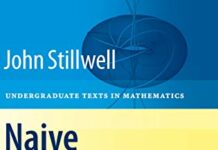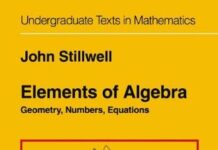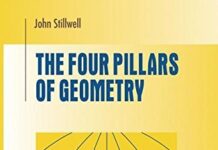
Ebook Info
- Published: 2006
- Number of pages: 230 pages
- Format: PDF
- File Size: 11.19 MB
- Authors: John Stillwell
Description
This book explores the history of mathematics from the perspective of the creative tension between common sense and the “impossible” as the author follows the discovery or invention of new concepts that have marked mathematical progress: – Irrational and Imaginary Numbers – The Fourth Dimension – Curved Space – Infinity and others The author puts these creations into a broader context involving related “impossibilities” from art, literature, philosophy, and physics. By imbedding mathematics into a broader cultural context and through his clever and enthusiastic explication of mathematical ideas the author broadens the horizon of students beyond the narrow confines of rote memorization and engages those who are curious about the place of mathematics in our intellectual landscape.
User’s Reviews
Editorial Reviews: Review Like the White Queen in Lewis Carroll’s Through the Looking-Glass, mathematicians are called upon to believe in things that, at first glance, defy common sense and appear impossible. . . . As Stillwell puts it, ‘Mathematics is a story of close encounters with the impossible because all its great discoveries are close to the impossible.’―Ivars Peterson, Science News , July 2006Stillwell weaves historical details into his writing seamlessly, helping to give the reader the true feeling that mathematics is more than just a bunch of people playing games with symbols, but rather a rich and rewarding intellectual endeavor important to the human enterprise. ―Marcus E. Barnes, MAA Reviews, August 2006Yearning for the Impossible is as much of a celebration of the greater understanding mathematics has brought to the world as it is a history and discussion of innovative concepts. and is highly recommended for library and personal reading shelves. ―Wisconsin Bookwatch, August 2006Rises nobly to the challenge of describing these topics to a genuine novice…There is much to admire in Stillwell’s attempt… he’s accomplishing something very important and difficult here in demonstrating that there’s some real struggle present in the process of mathematical discovery. ―Daniel Biss, Notices, June 2007Yearning for the Impossible offers a fascinating, historical look at some popular mathematical concepts used in music, art and philosophy. . . This book is an interesting find and provides a readable approach to some higher-level mathematics. The chapters can be read independently, and the reader can dig deeper into textbooks and history books for additional problems and details. I give a high recommendation for this book!―Lynn Godshall, Convergence Magazine (MAA), June 2007A wonderful journey through mathematical discoveries… this book is an excellent vehicle for giving mathematics students new research ideas and, most important, for planting the seed in their minds to ‘yearn for the impossible’ as they investigate new truths.―Mathematics Teacher, August 2007Stillwell has achieved what many might well have come to believe to be nearly impossible in mathematical exposition for the masses…[he] succeeds, in every topic treated, in bringing a fresh eye to questions even mathematicians might think have been mined in the past to boring exhaustion [and] shows there is still a lot of gold to be found, if one only thinks about things in a new way. Stillwell brings new, unorthodox insights to his writing that will stimulate readers (from high schoolers to emeritus professors) to think about old topics in new, nonstale ways… Yearning for the Impossible will be a treat for teachers, too, who are looking for new ways to bring stimulating, fresh examples into their courses. ―SIAM Review, May 2007Stillwell does an excellent job laying the historical foundations for these discoveries; he is to be commended for his historical accuracy. ―Recreational Math, March 2007Mathematics may be described as a story of close encounters with the impossible because all great discoveries are close to the impossible. The aim of this book is to tell this story, briefly and with few prerequisites, by presenting some representative encounters across the breadth of mathematics.―CMS Notes, May 2007This book explores history through a lens focused on the creative tension between common sense and the ‘impossible’ . . . Drawing connections to art, literature, philosophy, and physics, this book examines the place of mathematics in our intellectual landscape.―L’Enseignement Mathématique, January 20062009 Alpha Sigma Nu Book Award in the Discipline of Mathematics/Computer Science ―The Association of Jesuit Colleges & Universities, November 2009 About the Author John Stillwell, originally from Melbourne, Australia, is a Professor of Mathematics at the University of San Francisco. He earned his MSc in 1965 from the University of Melbourne and his PhD from MIT in 1970. His writing covers a wide spectrum of mathematics, including translations of classic texts by Dirichlet, Dedekind, Poincaré, and Dehn. He is also the author of Mathematics and Its History, The Four Pillars of Geometry, and Elements of Number Theory, among others. In 2005, he was awarded the Chauvenet Prize of the Mathematical Association of America for his expository writing
Reviews from Amazon users which were colected at the time this book was published on the website:
⭐I liked this book. I particularly liked Chapter 1, The Irrational, Chapter 5, Curved Space, and Chapter 6, The Fourth Dimension.Chapter 7, The Ideal, is also excellent and alone worth the purchase price, albeit the reader needs to follow closely the notational details and diagrams. In fact Chapter 7 is the reason I bought the book in the first place. I had always struggled with this important concept and was pleasantely surprised upon finding a book–Stillwell’s–that devoted a whole chapter to the subject at an introductory as well as historical level. The author follows the development of the notion of the ideal concept from Gauss, to Kummer, to Dedekind’s final generalization, where the payoff comes in Section 7.8. “Ideals, or Unique Prime Factorization Regained”.
⭐If you look at the other reviews you’ll see they are all full of praise. I really expected very much from this book, but the more I read in it the more I got disappointed. The material presented is indeed interesting, but the author’s way of explaining things is quite often less than ideal. If this book had been written by someone like Paul Nahin, William Dunham or Adrian Paenza it would have been much better. Knowing much is one thing, explaining it the best way is another and unfortunately Stillwell isn’t particularly good at the last thing.
⭐Book deals with “problems in the history of mathematics and applied mathematics. Areas include perspective drawing (projective geometry,) quadratic equations “with no solutions” (complex numbers,) limit big values (calculus,) and the mathematical scandals hidden by the Pythagorean’s in antiquity (lack of rational numbers for pi and the square root of two and the slight problem with their system of perfect musical tuning.)
⭐Great work Stillwell
⭐The chapters on geometry—projective geometry and hyperbolic geometry in particular—are extremely beautiful. We study many picturesque ideas, wonderful in themselves, that arise as “impossibly” neat solutions to interesting problems (perspective drawing, axiomatisation of geometry, shape of the universe, etc.), and then pay off by supplying unexpected insights elsewhere (e.g., the connection between projectively generated arithmetic and hypercomplex number systems that deserves to be better known). The chapters on complex numbers and quaternions are also very interesting. There are “unrecognised appearances” of complex numbers in already in Diophantus’s number theory, namely the equivalent of complex multiplication in the context of sums of two squares. Thousands of years later, when the geometry of complex numbers was established, the search for a three dimensional analog failed and one had to settle for the analog in four dimensions. The historical circle closed beautifully when Graves noted with surprise and satisfaction that this state of affairs is precisely mirrored in classical number theory where Diophantus’s theorem on sums of two squares generalises to four squares but not three. Stemming from the same roots in classical number theory, there is also an excellent chapter on algebraic number theory. Just as in his proof of the non-existence of three dimensional hypercomplex numbers in the quaternion chapter, Stillwell here takes on some very serious mathematics that many mathematicians would tell you require plenty of abstract algebra. But Stillwell knows better, cutting to the core of things with beautifully clear geometric arguments in both these cases. The other chapters are less innovative, although we are happy with the initiative to derive the infinite series for pi (essentially by the power series for the arctangent) only ten pages after the idea of infinitesimals is introduced (again relying on geometric methods rather than, as others would have it, abstract theories like Taylor’s theorem). The role of the impossible in mathematics is pointed out along the way, and Stillwell offers some rewarding reflections on this subject; these are highly retrospective, however, and if we were to take this topic seriously we would have wished for greater insights into the historical mathematicians’ thoughts on these supposedly impossible things.
⭐While browsing this book on the shelf of the Singapore National Library one sunday, I was shocked and delighted to spot on the chapter 7 of “Ideal”. Being a Mathematics student of Abstract Math 30 years ago, I could not find a satisfactory answer from my French University Math professors or any Math books who could tell me what does this “Ideal” concept really mean beyond its arcane definition, where did it derive from, and why most textbooks insert “Ideal” in the chapter of Ring Theory?Prof John Stillwell did a beautiful job by explaining in simple layman language the historical background of Kummer’s work on FLT (Fermat Last Theorem), who encountered the controversy of Fundamental Law of Arithematics with Algebraic Number extended Field [a+ SQRT(-b)]. So instead of giving up, Kummer ‘faked’ the ‘Ideal’ number which he guessed could resolve the conflict. It was after his death that Dedekind discovered prime ideal, principal ideal’s existence hidden in the compound of other numbers (Greatest Common Divisors of Rationals and Algebriac numbers, to be exact). Beautiful fake and discovery story in Mathematics!
⭐This book, which can be viewed as a prequel to Stillwell’s “History of mathematics”, is an excellent resource for someone who wishes to get a view of mathematics as a field of inquiry driven by the need to solve problems as much as by creative desire to uncover connections between seemingly unrelated ideas by people who made mathematics, such as Gauss, Hamilton, Abel, Euler, Riemann. There are lively short essays about these and other great mathematicians. When read along with regular (good) textbooks on, e.g., complex variables, geometry, the two Stillwell’s books will lead to a much better understanding of mathematical ideas.
⭐We only find in this book just superficial treatments. Got disappointed.
Keywords
Free Download Yearning for the Impossible: The Surprising Truths of Mathematics in PDF format
Yearning for the Impossible: The Surprising Truths of Mathematics PDF Free Download
Download Yearning for the Impossible: The Surprising Truths of Mathematics 2006 PDF Free
Yearning for the Impossible: The Surprising Truths of Mathematics 2006 PDF Free Download
Download Yearning for the Impossible: The Surprising Truths of Mathematics PDF
Free Download Ebook Yearning for the Impossible: The Surprising Truths of Mathematics



